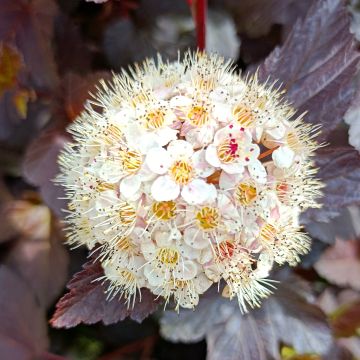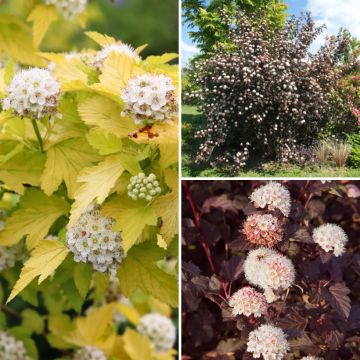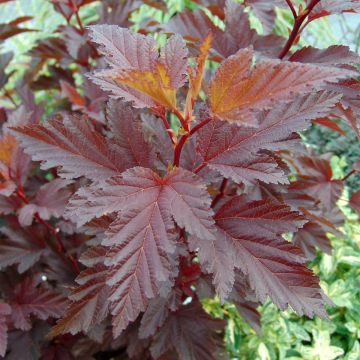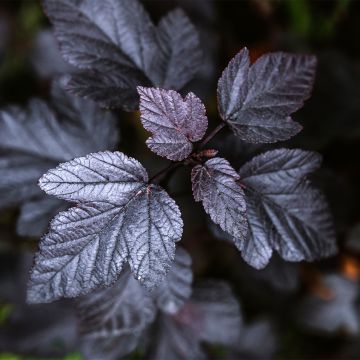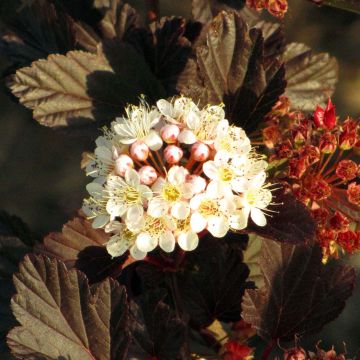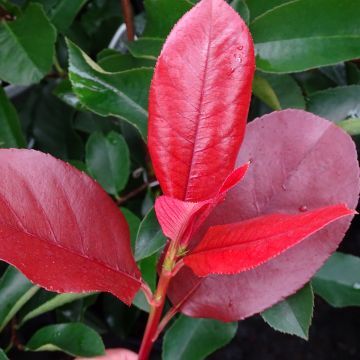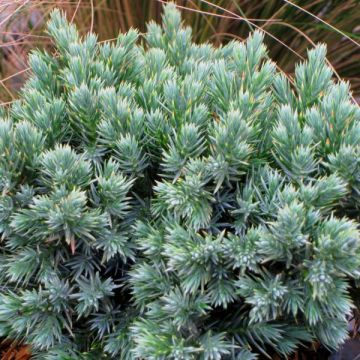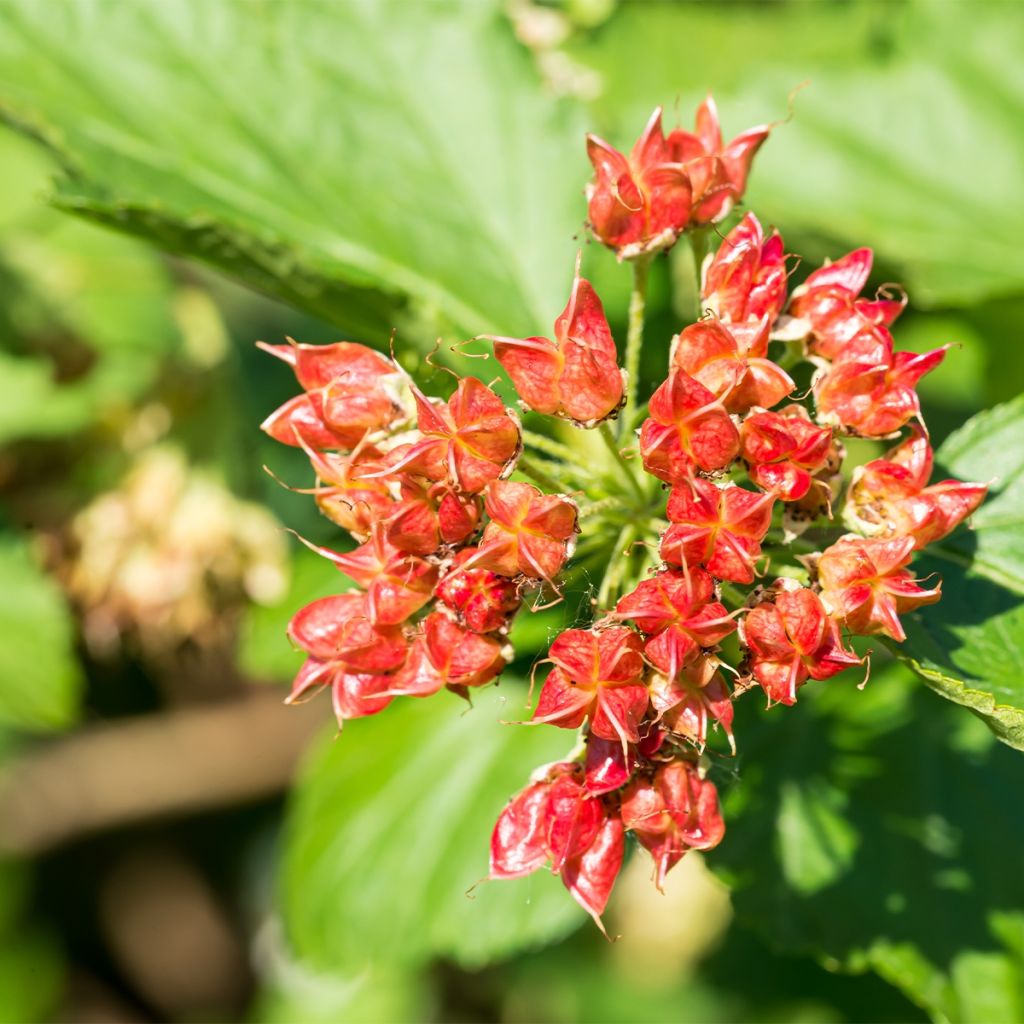

Physocarpe à feuilles d'Obier - Physocarpus opulifolius Magical Spring Sapphire
Physocarpus opulifolius Magical Spring Sapphire - Ninebark
Physocarpus opulifolius Magical Spring Sapphire (‘Kolmassa’)
Ninebark
Why not try an alternative variety in stock?
View all →This plant carries a 24 months recovery warranty
More information
We guarantee the quality of our plants for a full growing cycle, and will replace at our expense any plant that fails to recover under normal climatic and planting conditions.
From €5.90 for pickup delivery and €6.90 for home delivery
Express home delivery from €8.90.
Does this plant fit my garden?
Set up your Plantfit profile →
Description
Physocarpus opulifolius Magical Spring Sapphire ('Kolmassa') is a brand new variety of Physocarpus that will charm with its beautiful bright red fruiting, especially bright as it sits on a spring green foliage and retains its appeal throughout the summer. Like all Physocarpus, this deciduous bush blooms in late spring and its small clusters of white-pink flowers are highly visited by bees. Compact yet vigorous, this variety fits well in small gardens and works wonders in a large pot on the terrace or balcony.
Physocarpus opulifolius belongs to the Rosaceae family. Native to the eastern United States, up to Quebec and Manitoba, it is a deciduous bush in winter, very cold resistant. The recently obtained cultivar Magical Spring Sapphire, from the Netherlands, shows a bushy, erect and highly branched habit, supported by slightly arching branches as it grows freely. The growth of this bush is moderately fast and it will not exceed 80cm (32in) in all directions when fully grown.
Notable for the abundance and vibrant colour of its fruiting, the Magical Spring Sapphire Physocarpus is also adorned with ornamental foliage and a lovely late spring flowering. In May-June, 4cm (2in) diameter inflorescences appear in flattened corymbs, adorned with pink buds that open into lightly pinkish, nectar-rich flowers. They are followed by the formation of numerous small, shiny, bright red fruits, appreciated by birds in autumn. The leaves are lobed, deeply incised, toothed, crenate, and measure 3 to 7cm (1 to 3in) long. They take on a lovely yellow-orange to red colour in autumn before falling off. The bush remains decorative in winter, with its bark exfoliating into beige to reddish-brown flakes.
The 'Magical Spring Sapphire' Physocarpus will find its place in flowerbeds or borders, in contrast with dark foliage bushes ('Black Lace' Elderberry, 'All Black' Physocarpus), or on the contrary in harmony with light, golden foliage (Euonymus japonicus 'Aureovariegata', 'Golden Lanterns' Leycesteria formosa), or silvery (shrubby wormwoods, dwarf willows). It will also be charming in the company of Japanese spireas (Spirea 'Crispa', S.'Golden Princess') or a Neillia (Neillia affinis). Heucheras or Heucherellas could be planted at its base, for example, or even a Cerastostigma plumbaginoides with small electric blue flowers in summer and autumn. It will naturally make a great impression when planted in a pot on a terrace or balcony, where it can live for many years without requiring much maintenance.
The name Physocarpus opulifolius comes from the Greek 'phusa' which means air bubble or vesicle, and 'karpos' which refers to the fruit, in reference to the shape of the fruit. The resemblance of its foliage with that of the Viburnum opulus earned it its specific name "opulifolius". Introduced in Europe around 1687, the many shimmering cultivars that have been created in recent years have allowed its strong comeback in gardens.
Report an error about the product description
Plant habit
Flowering
Foliage
Botanical data
Physocarpus
opulifolius
Magical Spring Sapphire (‘Kolmassa’)
Rosaceae
Ninebark
Cultivar or hybrid
Other Physocarpus
Planting and care
Plant Physocarpus opulifolius Magical Spring Sapphire in deep, well-prepared, humus-rich, and rather moist soil, preferably neutral to acidic. It fears excessive limestone and excessively dry and/or compacted soils. Avoid letting the soil dry out in summer and shower the foliage during heatwaves. This bush will thrive in partial shade or in full sun. Thin out dense plants by severely pruning some of the arching branches after flowering. This may promote the development of new flower buds in late summer. The physocarpus tends to produce many suckers, to the detriment of the main plant; it may be useful to cut it back (removing all branches near the ground in spring) to give it a denser appearance.
Planting period
Intended location
Care
This item has not been reviewed yet - be the first to leave a review about it.
Foolproof Shrubs
Haven't found what you were looking for?
Hardiness is the lowest winter temperature a plant can endure without suffering serious damage or even dying. However, hardiness is affected by location (a sheltered area, such as a patio), protection (winter cover) and soil type (hardiness is improved by well-drained soil).

Photo Sharing Terms & Conditions
In order to encourage gardeners to interact and share their experiences, Promesse de fleurs offers various media enabling content to be uploaded onto its Site - in particular via the ‘Photo sharing’ module.
The User agrees to refrain from:
- Posting any content that is illegal, prejudicial, insulting, racist, inciteful to hatred, revisionist, contrary to public decency, that infringes on privacy or on the privacy rights of third parties, in particular the publicity rights of persons and goods, intellectual property rights, or the right to privacy.
- Submitting content on behalf of a third party;
- Impersonate the identity of a third party and/or publish any personal information about a third party;
In general, the User undertakes to refrain from any unethical behaviour.
All Content (in particular text, comments, files, images, photos, videos, creative works, etc.), which may be subject to property or intellectual property rights, image or other private rights, shall remain the property of the User, subject to the limited rights granted by the terms of the licence granted by Promesse de fleurs as stated below. Users are at liberty to publish or not to publish such Content on the Site, notably via the ‘Photo Sharing’ facility, and accept that this Content shall be made public and freely accessible, notably on the Internet.
Users further acknowledge, undertake to have ,and guarantee that they hold all necessary rights and permissions to publish such material on the Site, in particular with regard to the legislation in force pertaining to any privacy, property, intellectual property, image, or contractual rights, or rights of any other nature. By publishing such Content on the Site, Users acknowledge accepting full liability as publishers of the Content within the meaning of the law, and grant Promesse de fleurs, free of charge, an inclusive, worldwide licence for the said Content for the entire duration of its publication, including all reproduction, representation, up/downloading, displaying, performing, transmission, and storage rights.
Users also grant permission for their name to be linked to the Content and accept that this link may not always be made available.
By engaging in posting material, Users consent to their Content becoming automatically accessible on the Internet, in particular on other sites and/or blogs and/or web pages of the Promesse de fleurs site, including in particular social pages and the Promesse de fleurs catalogue.
Users may secure the removal of entrusted content free of charge by issuing a simple request via our contact form.
The flowering period indicated on our website applies to countries and regions located in USDA zone 8 (France, the United Kingdom, Ireland, the Netherlands, etc.)
It will vary according to where you live:
- In zones 9 to 10 (Italy, Spain, Greece, etc.), flowering will occur about 2 to 4 weeks earlier.
- In zones 6 to 7 (Germany, Poland, Slovenia, and lower mountainous regions), flowering will be delayed by 2 to 3 weeks.
- In zone 5 (Central Europe, Scandinavia), blooming will be delayed by 3 to 5 weeks.
In temperate climates, pruning of spring-flowering shrubs (forsythia, spireas, etc.) should be done just after flowering.
Pruning of summer-flowering shrubs (Indian Lilac, Perovskia, etc.) can be done in winter or spring.
In cold regions as well as with frost-sensitive plants, avoid pruning too early when severe frosts may still occur.
The planting period indicated on our website applies to countries and regions located in USDA zone 8 (France, United Kingdom, Ireland, Netherlands).
It will vary according to where you live:
- In Mediterranean zones (Marseille, Madrid, Milan, etc.), autumn and winter are the best planting periods.
- In continental zones (Strasbourg, Munich, Vienna, etc.), delay planting by 2 to 3 weeks in spring and bring it forward by 2 to 4 weeks in autumn.
- In mountainous regions (the Alps, Pyrenees, Carpathians, etc.), it is best to plant in late spring (May-June) or late summer (August-September).
The harvesting period indicated on our website applies to countries and regions in USDA zone 8 (France, England, Ireland, the Netherlands).
In colder areas (Scandinavia, Poland, Austria...) fruit and vegetable harvests are likely to be delayed by 3-4 weeks.
In warmer areas (Italy, Spain, Greece, etc.), harvesting will probably take place earlier, depending on weather conditions.
The sowing periods indicated on our website apply to countries and regions within USDA Zone 8 (France, UK, Ireland, Netherlands).
In colder areas (Scandinavia, Poland, Austria...), delay any outdoor sowing by 3-4 weeks, or sow under glass.
In warmer climes (Italy, Spain, Greece, etc.), bring outdoor sowing forward by a few weeks.

































